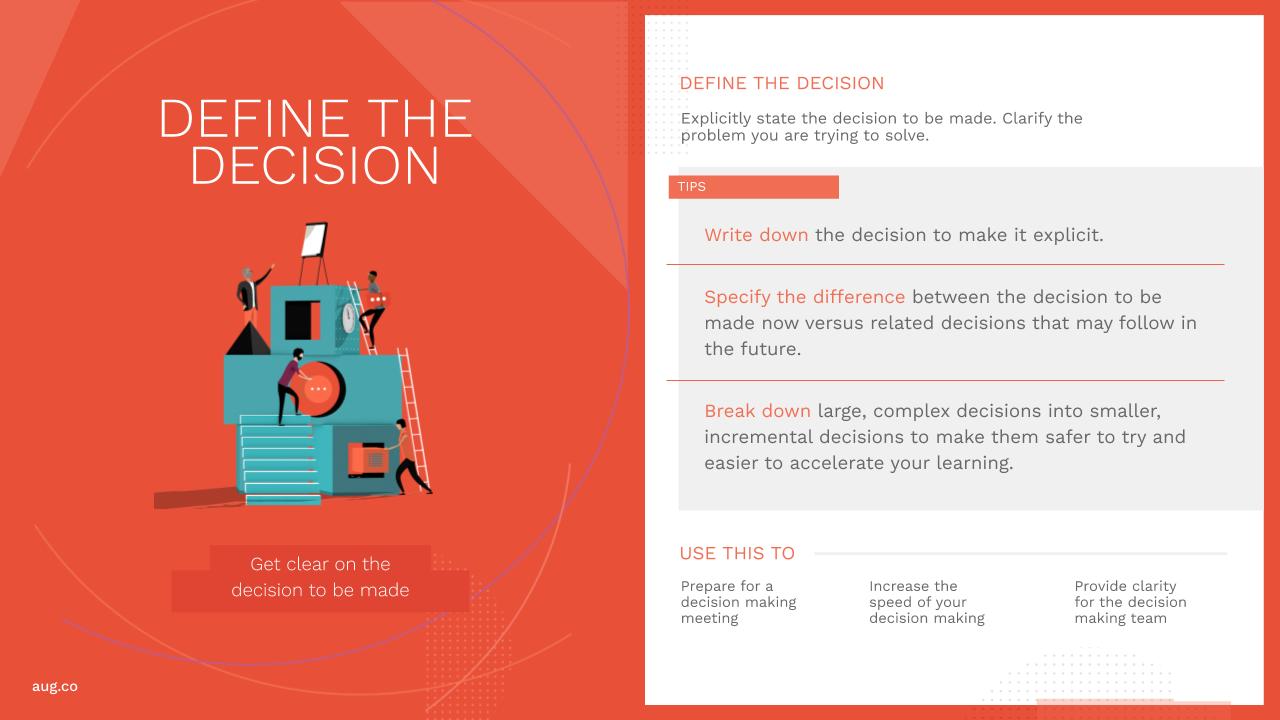Published November 14, 2020 | Updated February 18, 2021 | 4 minute read
Decision-making has become a priority for many companies. Especially in remote working conditions, learning how to come together to make high-quality, high-speed, and inclusive decisions is a competitive advantage.
Slow, opaque decision making is a chronic problem in most organizations. People rely on legacy decision-making habits that have been shaped over years of navigating and surviving in the workplace.
Many organizations have tried to improve decision-making by introducing frameworks (RACI, RAPID, “Who has the 'D'?”), and we've observed that these frameworks are often used just to document the dysfunction that already exists. Do you have ten people on your consult list? Great. Now how do you engage those stakeholders in a way that doesn't slow us down? Does the person with the 'D' still need to seek the approval of more senior role holders implicitly? If so, how can we solicit good advice and communicate boundaries that serve the organization rather than individual egos? To fix these issues, it helps to dig into the process, define good decision-making habits, and make them small and easy enough to practice so people can build fluency quickly.
Here are two simple decision-making practices that can profoundly change the way you approach decision-making in your organization.
- The first 'do-not-pass-go-do-not-collect-$200' moment of decision-making is to define the decision. This deceptively simple step can help teams avoid the trap door of trying to make several decisions in a single meeting. For example, a team will be discussing a vendor selection process, and as the conversation goes on, concerns about internal headcount to support this new resource allocation or issues with internal team conflict arise. At this moment, we can try to solve all of those problems before moving forward, or we can recognize that there are upstream decisions that we should make now and downstream decisions that we can make later. Capture the decision you are trying to make before jumping into a decision meeting, and if faced with a wall of future-anticipated-decisions- and considerations redirect the group by saying "That sounds like an important consideration for later, but not a reason for us to stop making this decision now."
- Another small but significant linguistic shift is how we talk about decisions in the decision-making meeting. A lot of us fall back on questions like: “How does everyone feel about this decision?” Or “Is everyone aligned here?” Even though our intention isn't to stall decision-making, these are implicit consensus-seeking questions. And we know that consensus is an overused and misused tool for decision-making. If we insist on waiting until everyone agrees that we’ve chosen the ideal path forward, we’re unlikely to ever move forward at all. The reality is that for most of our decisions, especially in the current, uncertain environment, we're simply trying to learn our way forward and should not rely on consensus. Consensus is a high-cost decision-making method that should be reserved for very few, very high consequence decisions. Consensus seeking can also be misused as a CYA tool to share accountability for a particular decision. When we default to consensus, no single person has to take responsibility. Instead of defaulting to these consensus-seeking behaviors, try introducing a new way of talking about decisions. In your next meeting ask, "Is this safe enough to try, knowing we can revisit it once we have more data?" Or "Does anyone have any data that this is not safe to try?" Or, “This might not be the perfect solution, but is it worth trying?” These pointed questions are hallmarks of a consent-based decision process. Consent, the lesser-known cousin of consensus, is a powerful practice to move decision-making forward. Essentially instead of trying to find the average of all opinions or design everyone's preferred solution, we are looking for a 'safe enough to try' decision that helps us take action and learn.
The August responsive practice cards below can support you in defining the decision, choosing a decision method, and using the consent process.



These decision-making practices can start to change the way you make decisions today. They are simple enough to get started and can be used by an individual or a team without having to revisit your entire organization’s decision-making process. We’ll continue to share decision-making practices and stories in August’s fall decision making series via LinkedIn and our blog. We also invite you to join us for one of our decision making webinars this November and December.







